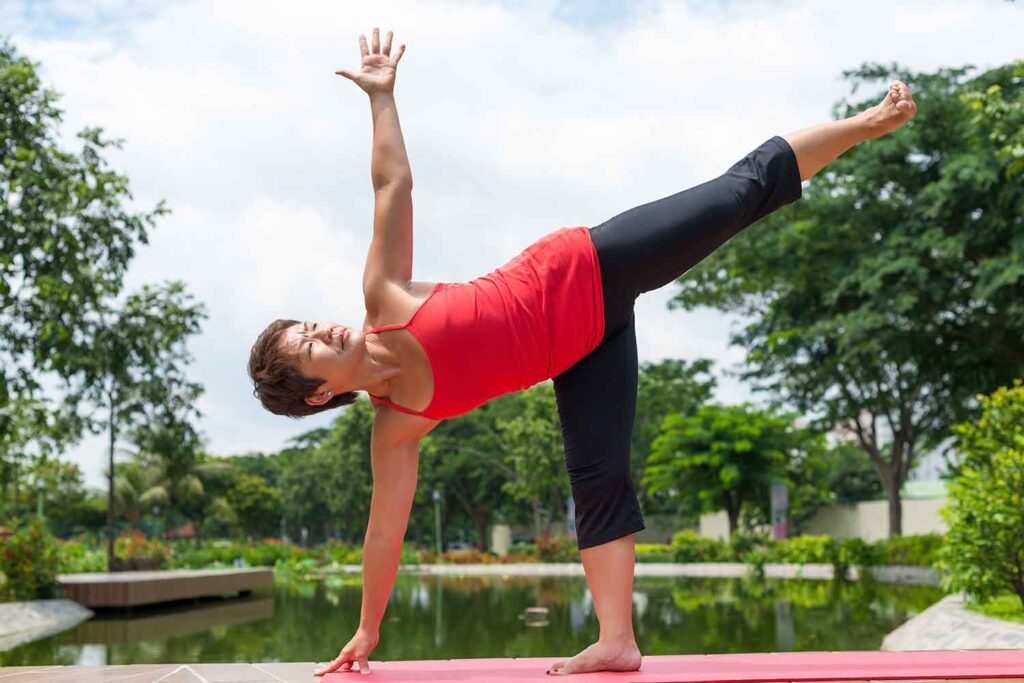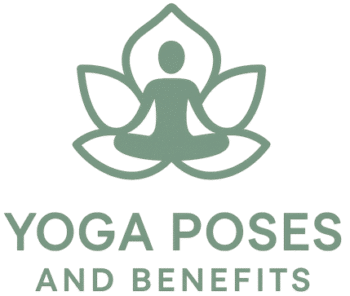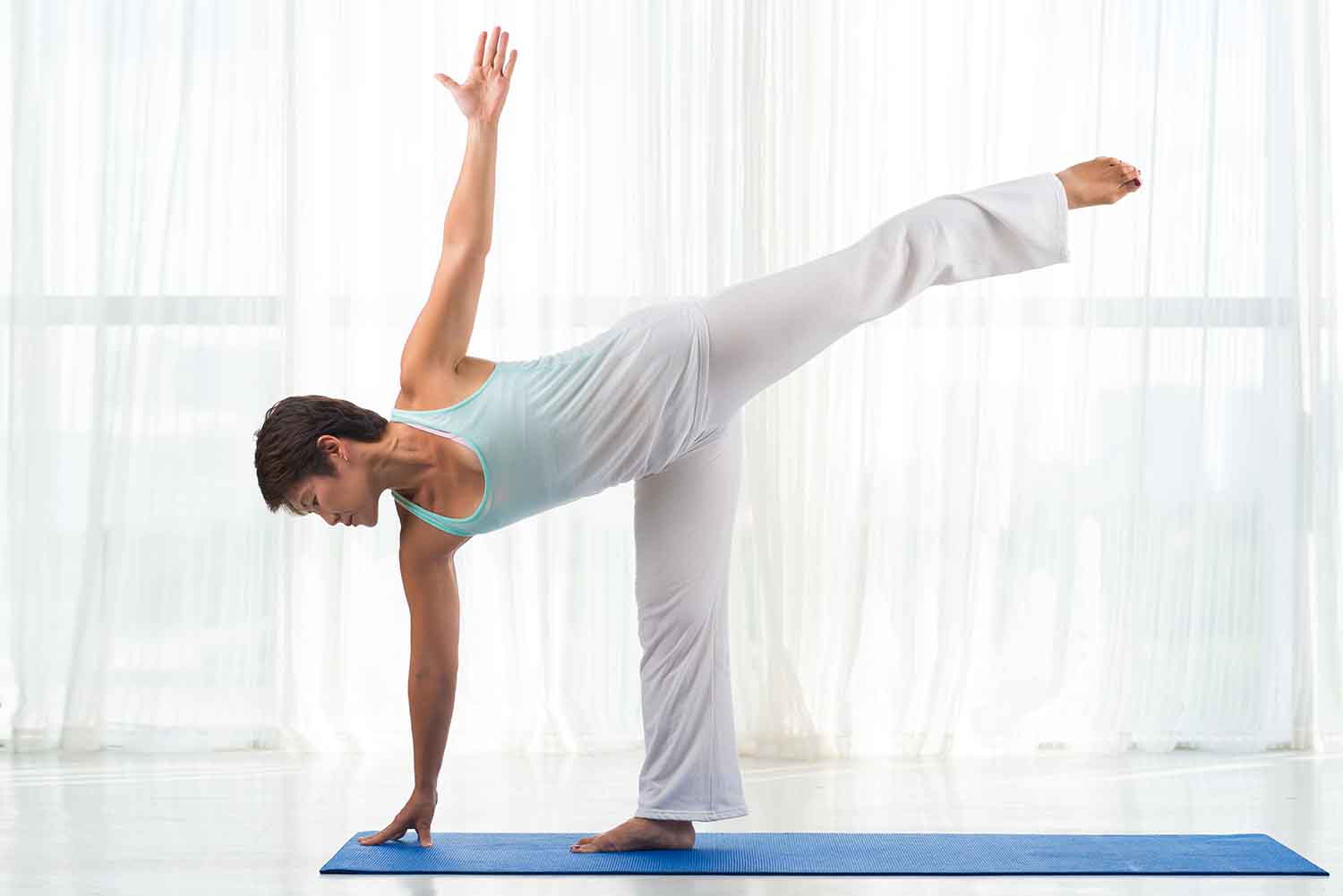Half Moon Pose in yoga (Ardha Chandrasana) is a dynamic balancing pose that focuses on improving coordination, flexibility, and strength. This pose opens the hips, strengthens the legs, and stretches the spine, enhancing your sense of stability and balance. Practicing Half Moon Pose requires both physical and mental concentration, making it a beneficial addition to any yoga practice.
To perform Half Moon Pose, start from Triangle Pose. Shift your weight into your front foot, lifting the back leg and extending it in line with your hips. The bottom hand reaches toward the ground, supporting your balance, while the other arm extends upward, creating a straight line from the top hand to the grounded one. This posture opens the chest and hips while engaging the core and legs for balance. Half Moon Pose can be challenging, but with practice, it helps build strength, stability, and focus.
Other Names for Half Moon Pose
Here are common names for Half Moon Pose:
- Ardha Chandrasana (Sanskrit)
- Balancing Half Moon
- Crescent Pose
- Side Balance Pose
These names highlight the importance of balancing and stretching laterally while cultivating strength and concentration.
How to Do Half Moon Pose
To perform Half Moon Pose, follow these steps:
- Begin in Triangle Pose with your right leg forward. Shift your weight onto your right foot and place your right hand on the ground or a block a few inches in front of your foot.
- Lift your left leg parallel to the floor, keeping it strong and engaged. Ensure your hips stay open, stacking the left hip over the right.
- Extend your left arm toward the ceiling, creating a straight line from your bottom hand to the top.
- Your gaze can remain forward, or for a challenge, look up toward your left hand.
- Engage your core to maintain balance, and keep your standing leg strong, but avoid locking the knee.
Hold the pose for several breaths before slowly lowering the lifted leg and transitioning back into Triangle Pose. Half Moon Pose offers a powerful stretch for the entire body while cultivating balance and strength.
Variations of Half Moon Pose
Variations of Half Moon Pose can enhance its benefits or make it more accessible:
- Sugarcane Pose (Ardha Chandra Chapasana): Bend the back leg and grasp your ankle with your top hand for an intense quadriceps stretch and a deeper opening of the chest and shoulders.
- Supported Half Moon: Place a block under your bottom hand for extra stability and balance support.
- Revolved Half Moon (Parivrtta Ardha Chandrasana): Rotate your torso to face the opposite direction, extending your bottom hand toward the floor and your opposite arm toward the ceiling. This adds a twist to the balance challenge.
These variations allow you to explore deeper stretches and refine your balance skills.

Modifications for Half Moon Pose
Modifications make Half Moon Pose more accessible for all levels:
- Use a Block: Place a yoga block under your supporting hand for extra stability. This reduces the strain on the wrist and helps with balance.
- Wall Support: Perform Half Moon against a wall for balance support, which can help you focus on alignment without worrying about falling.
- Bent Standing Knee: If your balance is wobbly, bend your standing knee slightly to find more stability and avoid hyperextension.
These modifications help students of all levels safely experience the benefits of Half Moon Pose.
Contraindications for Half Moon Pose
Consider these contraindications before practicing Half Moon Pose:
- Ankle or Knee Injuries: Since Half Moon relies on the stability of the standing leg, those with injuries in these areas should avoid or modify the pose.
- Shoulder Injuries: Lifting the top arm or keeping the bottom arm grounded may strain a sensitive shoulder.
- Balance Issues: If you experience dizziness or balance challenges, perform Half Moon against a wall or avoid the pose until you develop better coordination.
- Pregnancy: Due to balance requirements and abdominal involvement, Half Moon Pose should be approached with caution during pregnancy.
Always consult a healthcare professional if you have concerns about practicing Half Moon with any of these conditions.
Tips to Improve Half Moon Pose
Refine your Half Moon Pose with these tips:
- Ground Your Foundation: Focus on pressing evenly through the standing foot, spreading the toes to create a strong base.
- Engage the Core: Keep your core active to stabilize the torso and prevent collapsing into the lower back.
- Lengthen Through the Spine: Imagine extending from the crown of your head through the raised foot to keep your body aligned and lengthened.
- Gaze for Balance: Start by looking forward, and only move your gaze upward when you feel steady. This helps maintain your balance.
- Use a Prop: Don’t hesitate to use a block under your bottom hand. It helps you find more stability and length in the pose.
Incorporating these adjustments will help you feel more balanced and stable in Half Moon Pose.
What Muscles Does Half Moon Pose Work?
Half Moon Pose targets several muscle groups, strengthening and stretching the body simultaneously:
- Glutes and Hamstrings: The standing leg works to stabilize and balance the body, engaging the glutes and hamstrings.
- Core Muscles: The abdominal muscles, including the obliques and transverse abdominis, are engaged to maintain stability and alignment.
- Quadriceps: Both legs, particularly the standing leg, are strengthened in Half Moon Pose, helping develop the quadriceps.
- Back Muscles: The erector spinae support the lengthening of the spine, keeping the back aligned while in the pose.
- Shoulders and Arms: The top arm lifts and extends toward the sky, engaging the deltoids, while the bottom arm supports your weight.
This pose is excellent for building strength in the legs, core, and back, while stretching the hips and hamstrings.
Mental and Emotional Benefits of Half Moon Pose
Half Moon Pose provides several mental and emotional benefits:
- Focus and Concentration: Since Half Moon requires balance and stability, it enhances mental focus and concentration. The balance aspect encourages mindfulness.
- Confidence Boost: Successfully holding this challenging pose builds a sense of achievement and self-confidence.
- Stress Relief: Stretching and lengthening the body in this pose helps release physical tension, leading to emotional relaxation.
- Grounding and Stability: As a balancing pose, Half Moon fosters a sense of grounding, helping practitioners feel more centered and connected to the present moment.
Regular practice can help improve both mental clarity and emotional resilience.
Is Half Moon Pose Suitable for Beginners?
Half Moon Pose can be accessible for beginners, but it requires preparatory steps:
- Start with Triangle Pose: Practicing Triangle Pose helps establish the foundation needed for Half Moon.
- Use Props: Beginners can use a yoga block under the hand or practice against a wall to enhance stability.
- Work on Balance: Start by focusing on building balance in simpler standing poses before attempting Half Moon.
With the right modifications and preparatory poses, Half Moon can be integrated into a beginner’s yoga practice.
Is Half Moon Pose Suitable for Advanced Practitioners
For advanced practitioners, Half Moon Pose offers room for exploration and deeper engagement:
- Remove the Block: Try performing Half Moon without the support of a block, balancing entirely on your foot and core.
- Sugarcane Variation: Bend the lifted leg and reach for your ankle with your top hand, deepening the stretch in your hip flexors and quadriceps.
- Revolved Half Moon: Add a twist to the pose by transitioning into Revolved Half Moon, which requires more core strength and balance.
How Can I Deepen My Practice in Half Moon Pose?
To deepen your practice in Half Moon Pose (Ardha Chandrasana), focus on refining balance, alignment, and strength. Follow these tips to progress effectively:
- Warm Up Properly: Begin with poses that open the hips, stretch the hamstrings, and engage the core, such as Triangle Pose and Warrior II. These preparatory postures prepare the body for Half Moon’s demands on balance and flexibility.
- Engage the Core: A strong core provides stability in this balancing posture. Focus on drawing the navel toward the spine to support the lower back and help maintain balance.
- Refine Your Alignment: Ensure the shoulders stack directly above each other, and the chest opens toward the ceiling. This creates a feeling of expansion through the chest and helps avoid collapsing into the front leg.
- Utilize a Block: Place a block under your supporting hand to create stability and encourage proper alignment. This prop helps deepen the pose by allowing the body to focus on opening rather than balance alone.
- Activate the Lifted Leg: Keep the lifted leg energized by flexing the foot and pressing through the heel. This engagement helps maintain balance and encourages an active stretch.
- Extend the Gaze: Direct your gaze upward or forward, depending on your balance and comfort. This helps lengthen the spine and creates a sense of openness through the upper body.
- Focus on Breathing: Deep, steady breaths will enhance both balance and relaxation. Inhale to find stability and exhale to expand and deepen into the posture.
- Practice Regularly: Consistency is key to progressing in Half Moon Pose. With regular practice, balance improves, and deeper variations of the pose can be explored.
By incorporating these tips into your practice, you will gradually deepen your experience of Half Moon Pose, achieving more strength, balance, and openness over time.
What Are Some Common Mistakes in Teaching Half Moon Yoga Pose?
Common mistakes in teaching Half Moon Pose (Ardha Chandrasana) can limit the benefits and safety of the pose for students. Addressing these issues improves practice:
- Not Stacking Hips and Shoulders: Many students fail to properly stack the hips and shoulders, leading to misalignment. Encourage them to rotate the chest open and align the hips vertically for optimal balance and stretch.
- Collapsing Into the Standing Leg: Students may rely too much on their standing leg, which can strain the knee and reduce stability. Remind them to engage their core and distribute weight evenly between their standing leg and lifted leg.
- Neglecting the Core: A common mistake is not engaging the core muscles, causing instability. Cue students to draw their navel toward their spine to stabilize and maintain balance.
- Incorrect Foot Positioning: The lifted leg is often left loose, resulting in poor alignment. Encourage students to flex their lifted foot and engage the leg by pressing through the heel for a more active stretch.
- Forcing the Gaze: Forcing students to look upward can compromise balance, especially for beginners. Suggest they gaze forward or down until they develop the necessary stability.
- Skipping Props: Beginners may struggle with balance, and avoiding props like a block under the lower hand can lead to instability. Encourage the use of a block to help with alignment and balance.
By addressing these common mistakes, instructors can help students find better alignment, stability, and comfort in Half Moon Pose.
Is there a Warrior 4 pose?
There is no officially recognized Warrior 4 pose in traditional yoga sequences. Common warrior poses include Warrior I (Virabhadrasana I), Warrior II, and Warrior III. Some modern yoga instructors may refer to Half Moon Pose (Ardha Chandrasana) as Warrior 4 due to its strength and balance similarities.
What is the half moon pose good for?
The half moon pose is good for improving balance, core strength, and flexibility. It engages muscles in the legs, hips, and abdomen while enhancing spinal alignment and stability. Common in Hatha yoga and Vinyasa yoga, the pose also aids in coordination and concentration.
Why is the half moon pose so hard?
The half moon pose is challenging because it requires strong core stabilization, hip flexibility, and balance. This yoga posture engages muscles like the glutes, obliques, and quadriceps while testing proprioception. Tools such as a yoga block can help support alignment and ease the transition into Ardha Chandrasana.
Who should avoid Ardha Chandrasana?
Individuals with low blood pressure, migraines, or balance-related conditions should avoid Ardha Chandrasana, or Half Moon Pose. Those with recent hip, knee, or spinal injuries should also consult a healthcare provider before practicing this yoga pose due to its reliance on core strength, stability, and alignment.
What should you avoid in Half Moon Pose?
When practicing Half Moon Pose (Ardha Chandrasana), avoid collapsing the chest, locking the standing knee, or overextending the lifted leg. Improper alignment can strain the lower back or hips. Using a yoga block and practicing near a wall can help support balance and maintain proper form.
What is the alternative to the half moon pose?
An effective alternative to the half moon pose is triangle pose (Trikonasana) or extended side angle pose (Utthita Parsvakonasana), both of which build balance, strength, and flexibility. These standing yoga poses engage the core and open the hips and chest similarly to Ardha Chandrasana.

